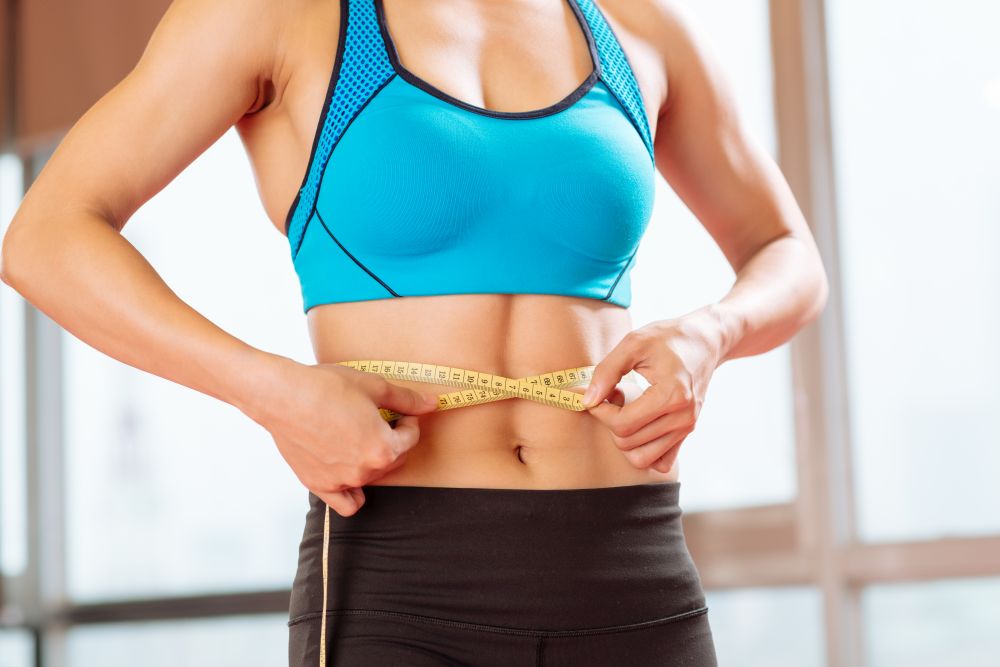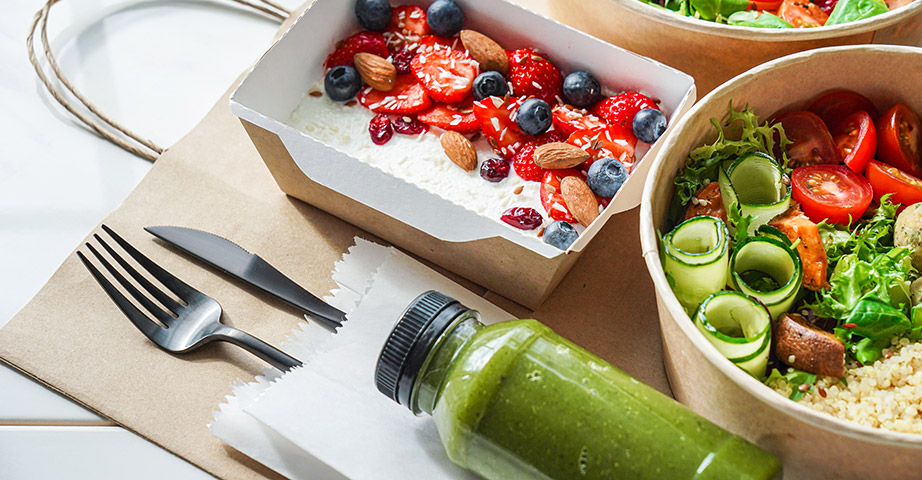Reduction diet - what do you need to know before you start using it?

In order for weight loss to be healthy, rational and not associated with the risk of yo-yo effect, the reduction diet must be properly balanced. The use of restrictive slimming treatments may bring various health problems such as fatigue, drowsiness, deterioration of well-being or weakening of concentration. Do you know what to eat for reduction? Do you have any doubts about what caloric content of the reduction diet will be appropriate during weight loss? What does reduction mean in general? Below you will find a handful of valuable information along with an example of a slimming diet.
Summary
What is weight reduction?
In a nutshell, a weight reduction is a strategy that involves the introduction of a caloric deficit. It means providing the body with fewer calories than its actual needs. The energy deficit should cover about 500-1000 kcal from total metabolism.
Consuming fewer calories should lead to weight loss in the range of 0.5-1.0 kg per week. At the same time, it should be remembered that healthy weight loss should be based on providing the body with all the nutrients that are needed for the proper functioning of the body. A rapid and significant reduction can result not only in a re-growth of kilograms, but also a significant loss of non-fat body mass, including mainly muscle tissue.
A reduction diet is a way of eating that aims to reduce body weight by limiting calorie intake. For this reason, it is dedicated primarily to people struggling with overweight and obesity, who want to reduce the amount of body fat and improve their overall health and well-being.
How many calories per day on reduction?
You already know what a reduction diet is and what its basic goals are. Another important issue that you need to pay attention to in order to effectively work through unnecessary kilograms is the caloric content of a slimming diet.
How to calculate how many calories should have a diet to reduce? Two methods are helpful. The first one consists in calculating caloric demand based on formulas for basic metabolism, total metabolism and proper body weight.
Basic metabolism
- for women = 665,09 + (9,56 x body weight [kg]) + (1,85 x height [cm]) – (4,67 x age [years]),
- for men = 66,47 + (13,75 x body weight [kg]) + (5 x height [cm]) – (6,75 x age [years]).
Total metabolism
- Total metabolism = basic metabolism x physical activity rate.
Proper body weight
- for women [kg] = height [cm] – 100 – 0.5 x (height [cm] – 150),
- for men [kg] = height [cm] – 100 – 0.25 x (height [cm] – 150).
To calculate the calorific value of the reduction diet, you can also use the application or calculator on websites. They include basic body parameters, the level of physical activity and the goal to achieve to find out what are your caloric demand and ideal body weight.
Recommended products for reduction diet
What to eat on diet for reduction?
The reduction diet should be properly balanced for macronutrients. Protein should be about 20-25% of energy from the whole diet, while fats 25-30%. The right amount of protein in the diet helps to avoid feeling hungry and also supports the feeling of satiety after a meal. In turn, fats are necessary for the proper absorption of vitamins A, D, E and K and participate in the synthesis of many important hormones in the body. How much fat do you consume for the reduction? According to the current nutrition standards, it is recommended to eat a minimum of 1 gram of fat per kilogram of body weight on the reduction diet.
In the reduction diet, there can also be carbohydrates, which should constitute 45-55% of all energy. In addition, people who aim to reduce body weight should ensure adequate intake of fibre in the amount of 25 to 30 g per day. The dietary fibre present in plant-based products not only improves digestion and regulates intestinal peristalsis, but also reduces the absorption of fats.
When deciding to limit calories, it is very important that the menu includes filling, balanced meals that provide the body with carbohydrates, protein and essential minerals. What to eat on the healthy reduction? The properly composed reduction diet should be based on:
- vegetables - on the reduction diet, it is worth reaching for low-calorie vegetables such as tomatoes, zucchini, celery, cauliflower, spinach, broccoli,
- fruits - in small quantities can eat fruits with a low glycemic index, which include, among others, peaches, gooseberries, oranges, raspberries, currants, blueberries and strawberries,
- complex carbohydrates - their best source are whole grain cereal products, groats, root vegetables and legumes,
- protein - found in lean beef, chicken, turkey, eggs, fish, cottage cheese, natural yoghurts and legumes,
- fats - present mainly in olive oil, linseed oil, rapeseed oil, nuts, avocado.
What not to eat on weight reduction?
An important element of the reduction diet is the regularity of meals rich in essential nutrients. During too long breaks, the metabolic rate decreases, which promotes the accumulation of fat, especially in the abdominal area. The reduction diet should consist of 4-5 smaller, well-balanced meals such as breakfast, second breakfast, lunch, afternoon tea and dinner.
People who want to get rid of unnecessary kilograms should also know what not to eat on the reduction. Products that should be excluded from the menu during weight loss are primarily:
- sweets,
- chips and salty snacks,
- ready meals and sauces,
- fast food,
- low quality meat products,
- confectionery products,
- coloured carbonated drinks,
- sweetened juices.
In addition, on the reduction diet, it is recommended to limit salt to 1 teaspoon per day and replace saccharose with xylitol or erythrol.
Diet for fat reduction - exemplary menu
Meals on reduction should be based on vegetables and fruits, which are a source of vitamins, minerals and dietary fibre. Vegetables should be chosen more often. It is best to consume them raw or after a short cooking to prevent the loss of valuable compounds. What vegetables can be eaten on the reduction? In the reduction diet, it is worth including fresh seasonal or frozen products (salad, kale, cabbage, chicory, peppers, aubergine, tomatoes, radish, onion, cucumber).
Breakfast on reduction
Breakfast on the reduction diet should include whole grains, a source of fat and protein, and vegetables or fruits. Exemplary breakfasts can you eat on the reduction:
- two slices of wholemeal bread with cottage cheese with chives, a handful of cherry tomatoes and a few pieces of radishes,
- oat flakes with yoghurt or milk, fresh fruit and nuts,
- banana-dactyl cocktail with cinnamon.
Lunch on reduction
Lunch on the reduction diet should be valuable and provide the right amount of energy. In this meal, it is worth taking into account complex carbohydrates, protein and healthy fatty acids. Exemplary lunch on the reduction:
- chicken breast marinated in spices with boiled potatoes and broccoli,
- pikeperch baked in foil with lemon juice and herbs with brown rice and sauerkraut salad,
- zucchini cream soup cooked on vegetables without meat.
Dinner on reduction
Dinner on the reduction diet should be easily digestible and eaten 2-3 hours before going to bed. For the last meal of the day, it is best to choose easily digestible and low-calorie products, at the same time rich in nutrients. Exemplary suggestions for dinner on the reduction:
- salad with tomato and olive oil, two frankfurters and a slice of wholemeal bread,
- grilled salmon with millet groats and steamed vegetables,
- salad with brown rice and turkey, red pepper, tomato and a teaspoon of sunflower seeds.

Supplementation with reduction diet
People who want to lose unnecessary kilograms must make many changes in everyday life. Unfortunately, achieving the intended results with the help of the reduction diet and physical activity is not easy. Dietary supplements supporting weight reduction may be a support in the process of weight loss. These types of preparations most often include vitamins, minerals, fibre, caffeine and natural plant extracts (e.g. green tea).
In addition, fat burners available in the form of tablets, capsules and ready-to-drink liquids may contain L-carnitine, beta-alanine, CLA (conjugated linoleic acid), berberine, curcumin. Before starting supplementation, it is worth knowing what effect the individual components show. It is also good to be aware that some preparations may contain ingredients not allowed to use and dangerous to health. That is why it is so important to buy supplements only from proven manufacturers who submit their products to regular laboratory tests.
Reduction diet - summary
The way of eating is important in the process of weight loss. People who want to get rid of excess body fat should pay special attention to the caloric demand and the amount of nutrients sufficient to meet the needs of the body.
The goal of the reduction diet is to achieve a energy deficit by reducing the intake of carbohydrates and fats. Physical activity also plays an important role in weight reduction, as it increases metabolism, helps in burning calories and adds energy to the work. Combining a healthy, balanced diet with regular exercise is the key to sliming figure and maintaining well-being.

